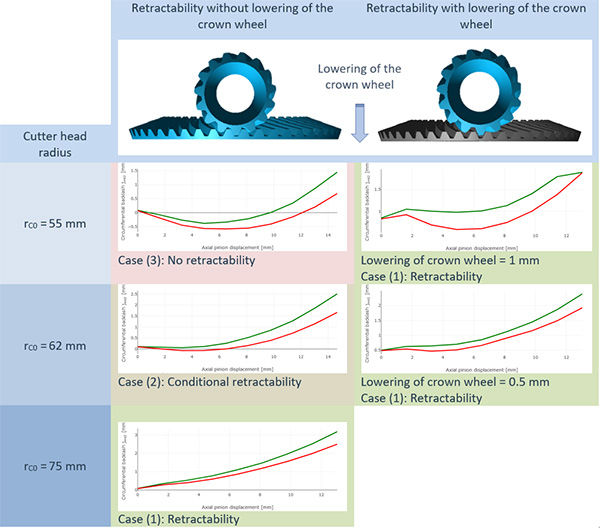The starting point for every calculation is the exact surface of bevel and hypoid gears and their position relative to each other. The descriptions of the tooth flank and tooth root are generated in a manufacturing simulation, taking machine settings and manufacturing deviations into account. Compensation areas are used to transform this discrete point cloud into a gapless mathematical description of the tooth surface.
The load-free tooth contact simulation is the core component of the rolling contact simulation, and can efficiently determine the key parameters of the gear. Relevant evaluation criteria include: the ease-off, the load-free working variation, the load-free contact pattern, determination of the backlash, and the axial retractability of the pinion (FVA Research Project 456 II ”BECAL - Backlash and Retractability,“ TU Dresden IMM, Prof. Dr. Schlecht).
The circumferential backlash is chosen based on the gear parameters, production quality, and the relative position deviations to be expected under load. This prevents meshing interference and gear jamming. Too little backlash can lead to jamming due to relative position deviations under load, too much can lead to increased noise and reduced load capacity.
In addition to the microgeometry, the mounting position, relative position deviations under load, and specified pitch deviations of the working and trailing flanks are considered when calculating the backlash.
In practice, bevel gears always include flank modifications. Therefore, the backlash is not constant when considered across the meshing positions (see Figure 1). The difference between the minimum and maximum backlash is caused by superposition of the working variations in drive and coast operation. The theoretical foundation for the backlash calculations was developed and implemented in FVA Research Project 223/XVIII (”BECAL – Operating Clearance,“ TU Dresden IMM, Prof. Dr. Schlecht). The influences related to backlash calculation are being reassessed in ongoing research projects in order to better reflect the actual conditions under load.
Representation of the average circumferential backlash over the angle of rotation of the crown wheel for 2 pitches in transverse section (graph taken from FVA-Workbench report).
Evaluation of the retractability of the pinion is another application for the circumferential backlash calculation. A pinion is retractable if it can be rotated out of the mesh and the pinion only moves along the gear axis. The relative position of the axis of the pinion only changes in the axial direction out of the mesh as a result. Retractability refers to both the mounting and disassembly procedures. This has an enormous influence, especially on the design of the casing. The question of whether or not the bevel pinion is axially retractable significantly influences the mounting and disassembly processes.
Retractability is calculated from the backlash. Therefore, the exact tooth form, including microgeometry and manufacturing deviations, is also taken into account here. The cutter head radius rc0 has the greatest influence on the retractability, as it determines the curvature of the flank in the longitudinal direction. This should be the very first thing to be adjusted in order to optimize the retractability. A larger cutter head radius increases the retractability, but is limited by economic considerations and a change in the displacement behavior, and therefore cannot simply be increased as desired.
A pinion is retractable if can be rotated out of the mesh along the pinion axis.
In the FVA-Workbench, the minimum and maximum backlash over the axial displacement of the pinion are graphically represented as a result of the retractability calculation. The following three cases can occur:
-
Retractability: The curves of the minimum and maximum backlash increase monotonously. The lowest values are located at the coordinate origin.
-
Conditional retractability: The lowest value of the minimum backlash is negative and the lowest value of the maximum backlash is positive. This means that there are meshing positions in the corresponding axial pinion positions in which the pinion and the crown wheel do not interpenetrate. Jamming while rotating the pinion and crown wheel toward each other can only be avoided under ideal conditions. Retractability cannot be assumed without additional testing.
-
No retractability: The minimum values are negative. This means that meshing interpenetration is calculated for all axial pinion positions with negative minimum and maximum backlashes. The gearing jams and the pinion cannot be moved axially.
The retractability results for a bevel gear with the basic geometry described in Table 1 are summarized in Figure 3.
Influence of the cutter head radius and lowering of the crown wheel on retractability.
Without retractability, the pinion can be mounted by placing it into the mesh in the axial direction of the crown wheel axis, or by lowering the crown wheel if the design allows (axial displacement of the crown wheel out of the mesh). Axial retractability of the pinion can be achieved under these conditions (see Figure 3). In this case, it should be verified that the value specified for the lowering of the crown wheel is sufficient for the retractability calculation.









